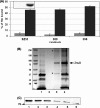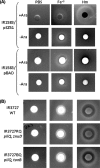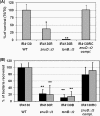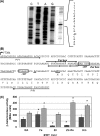The Neisseria meningitidis ZnuD zinc receptor contributes to interactions with epithelial cells and supports heme utilization when expressed in Escherichia coli
- PMID: 22083713
- PMCID: PMC3264319
- DOI: 10.1128/IAI.05208-11
The Neisseria meningitidis ZnuD zinc receptor contributes to interactions with epithelial cells and supports heme utilization when expressed in Escherichia coli
Abstract
Neisseria meningitidis employs redundant heme acquisition mechanisms, including TonB receptor-dependent and receptor-independent uptakes. The TonB-dependent zinc receptor ZnuD shares significant sequence similarity to HumA, a heme receptor of Moraxella catarrhalis, and contains conserved motifs found in many heme utilization proteins. We present data showing that, when expressed in Escherichia coli, ZnuD allowed heme capture on the cell surface and supported the heme-dependent growth of an E. coli hemA strain. Heme agarose captured ZnuD in enriched outer membrane fractions, and this binding was inhibited by excess free heme, supporting ZnuD's specific interaction with heme. However, no heme utilization defect was detected in the meningococcal znuD mutant, likely due to unknown redundant TonB-independent heme uptake mechanisms. Meningococcal replication within epithelial cells requires a functional TonB, and we found that both the znuD and tonB mutants were defective not only in survival within epithelial cells but also in adherence to and invasion of epithelial cells. Ectopic complementation rescued these phenotypes. Interestingly, while znuD expression was repressed by Zur with zinc as a cofactor, it also was induced by iron in a Zur-independent manner. A specific interaction of meningococcal Fur protein with the znuD promoter was demonstrated by electrophoretic mobility shift assay (EMSA). Thus, the meningococcal ZnuD receptor likely participates in both zinc and heme acquisition, is regulated by both Zur and Fur, and is important for meningococcal interaction with epithelial cells.
Figures






Similar articles
-
An outer membrane receptor of Neisseria meningitidis involved in zinc acquisition with vaccine potential.PLoS Pathog. 2010 Jul 1;6(7):e1000969. doi: 10.1371/journal.ppat.1000969. PLoS Pathog. 2010. PMID: 20617164 Free PMC article.
-
ZnuD, a potential candidate for a simple and universal Neisseria meningitidis vaccine.Infect Immun. 2013 Jun;81(6):1915-27. doi: 10.1128/IAI.01312-12. Epub 2013 Mar 18. Infect Immun. 2013. PMID: 23509142 Free PMC article.
-
The molecular mechanism of Zinc acquisition by the neisserial outer-membrane transporter ZnuD.Nat Commun. 2015 Aug 18;6:7996. doi: 10.1038/ncomms8996. Nat Commun. 2015. PMID: 26282243 Free PMC article.
-
Iron transport systems in Neisseria meningitidis.Microbiol Mol Biol Rev. 2004 Mar;68(1):154-71. doi: 10.1128/MMBR.68.1.154-171.2004. Microbiol Mol Biol Rev. 2004. PMID: 15007100 Free PMC article. Review.
-
Members of the Fur protein family regulate iron and zinc transport in E. coli and characteristics of the Fur-regulated fhuF protein.J Mol Microbiol Biotechnol. 2002 May;4(3):217-22. J Mol Microbiol Biotechnol. 2002. PMID: 11931550 Review.
Cited by
-
Nutritional immunity: transition metals at the pathogen-host interface.Nat Rev Microbiol. 2012 Jul 16;10(8):525-37. doi: 10.1038/nrmicro2836. Nat Rev Microbiol. 2012. PMID: 22796883 Free PMC article. Review.
-
A TonB dependent transporter YncD of Salmonella enterica Serovar Typhi possesses vaccine potential.World J Microbiol Biotechnol. 2024 Mar 12;40(4):131. doi: 10.1007/s11274-024-03937-9. World J Microbiol Biotechnol. 2024. PMID: 38470539
-
Application of TonB-Dependent Transporters in Vaccine Development of Gram-Negative Bacteria.Front Cell Infect Microbiol. 2021 Jan 27;10:589115. doi: 10.3389/fcimb.2020.589115. eCollection 2020. Front Cell Infect Microbiol. 2021. PMID: 33585268 Free PMC article. Review.
-
The Zinc Nutritional Immunity of Epinephelus coioides Contributes to the Importance of znuC During Pseudomonas plecoglossicida Infection.Front Immunol. 2021 May 4;12:678699. doi: 10.3389/fimmu.2021.678699. eCollection 2021. Front Immunol. 2021. PMID: 34017347 Free PMC article.
-
The zinc-responsive regulon of Neisseria meningitidis comprises 17 genes under control of a Zur element.J Bacteriol. 2012 Dec;194(23):6594-603. doi: 10.1128/JB.01091-12. Epub 2012 Oct 5. J Bacteriol. 2012. PMID: 23043002 Free PMC article.
References
-
- Bilukha OO, Rosenstein N. 2005. Prevention and control of meningococcal disease. Recommendations of the Advisory Committee on Immunization Practices (ACIP). MMWR Recomm. Rep. 54:1–21 - PubMed
Publication types
MeSH terms
Substances
Grants and funding
LinkOut - more resources
Full Text Sources

